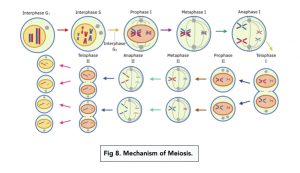Cell Division By Meiosis (A-level Biology)
Cell Division By Meiosis
Mechanism of Meiosis
Meiosis is essentially two rounds of mitosis, but with some very important differences. You start with 1 diploid cell, and end up with 4 haploid cells.
1) Interphase
Before meiosis I, interphase occurs. There is DNA replication and growth of the cell, just like we learnt in the previous tutorial on mitosis. Interphase consists of two phases:
- S phase – DNA replication
- Growth phase (G1 + G2) – new proteins and organelles are made
2) Meiosis I
- Meiosis I is essentially like mitosis. Meiosis I results in the production of two diploid daughter cells. Each of the phases of meiosis I are the same as normal mitosis, except we refer to them as prophase I, metaphase I, anaphase I, and telophase I.
- Crossing over occurs in meiosis I. During meiosis I, a very important event known as crossing over occurs during prophase I. This does not occur in mitosis. We will learn more about this later.
- Two diploid daughter cells are produced. The remainder of meiosis I is exactly the same as mitosis. The homologous chromosomes are separated from each other and assorted into two diploid daughter cells.
3) Meiosis II
During meiosis II, the two diploid daughter cells divide in order to produce a total of four haploid daughter cells, each with a single copy of every chromosome (only 23 chromosomes total per cell). The steps of meiosis II are summarised below:
a) Prophase II
-
- If the nuclear envelope was re-made after telophase I, it will break down again.
- The nucleolus disintegrates, the chromosomes condense and spindles are made.
b) Metaphase II
-
- The chromosomes line up in the centre (equator) and bind to the spindle fibres at the centromeres.
- The chromatids of each chromosome are independently assorted (see later).
c) Anaphase II
-
- The spindle fibres pull the chromatids to opposite ends of the cell. The centromere divides.
d) Telophase II
-
- In each cell, two nuclear envelopes will develop to form two haploid nuclei.
- The two cell divide by cytokinesis to produce four haploid daughter cells.

Cell division is the process by which a single cell divides into two or more daughter cells. This is an essential process for the growth and repair of tissues, as well as for the reproduction of organisms.
Meiosis is a type of cell division that results in the formation of four genetically diverse daughter cells, each with half the number of chromosomes as the parent cell.
Meiosis is important because it plays a key role in sexual reproduction, producing gametes (eggs and sperm) that are necessary for fertilization to occur.
Mitosis and meiosis are both types of cell division, but they have different outcomes. Mitosis results in two identical daughter cells, each with the same number of chromosomes as the parent cell, while meiosis results in four genetically diverse daughter cells with half the number of chromosomes.
Meiosis can be broken down into two main stages: meiosis I and meiosis II. During meiosis I, homologous chromosomes (pairs of chromosomes with the same genes) are separated, while during meiosis II, the chromatids (each half of a duplicated chromosome) are separated.
Crossing over is a process that occurs during meiosis I where genetic material is exchanged between homologous chromosomes. This results in the formation of new combinations of genetic material, creating genetic diversity in the daughter cells.
Meiosis contributes to genetic diversity by allowing for the shuffling of genetic material through crossing over and the random alignment of chromosomes during meiotic cell division. This results in the formation of genetically diverse daughter cells.
A tetrad is a group of four chromatids that are formed during meiosis I and are a result of the duplication of chromosomes. The formation of tetrads allows for accurate separation of chromosomes during meiosis I and ensures that each daughter cell receives the correct number of chromosomes.
Errors in meiosis can have serious implications, such as the formation of aneuploid cells (cells with an abnormal number of chromosomes) or the production of genetically unbalanced gametes. These errors can lead to genetic disorders or other health problems.
An understanding of meiosis is important for A-Level Biology students because it provides a foundational understanding of sexual reproduction, genetic diversity, and the mechanisms that contribute to the formation of new genetic combinations. This knowledge is essential for further studies in biology, genetics, and related fields.






Still got a question? Leave a comment
Leave a comment